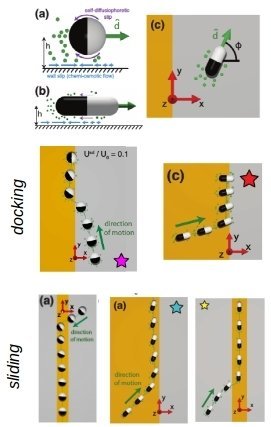Active Matter
|
Researchers: |
Dr. Mihail N. Popescu (contact person) |
 |
|
|
Collaborators: |
Prof. Alvaro Dominguez (Univ. of Seville) |
An important class of active matter systems is that of chemically active colloids. These particles can achieve self-propulsion via the catalytic promotion of chemical reactions in the surrounding solution on their surface. Such systems serve as benchmark examples for non-equilibrium processes, while from an application viewpoint they are envisioned, e.g., to act as "carriers" in novel lab-on-a-chip devices. Our efforts are aimed at understanding the complex behavior exhibited by chemically active colloids when they operate nearby confining walls or soft-interfaces, or in the presence of external flows and fields, e.g.:
Active particles near or at interfaces
| ⚫ |
The self-generated hydrodynamic and chemical fields, which induce particle motion, probe and are modified by that very environment, including confining hard walls. These changes couple back to the particle motion via the phoretic slip on the particle surface and lead to the emergence of "wall-bounded" steady-states such as sliding and hovering. Furthermore, it has been shown that the occurrence of such states is a robust feature, with respect to various models of chemical activity, of the dynamics of such particles near walls. |
 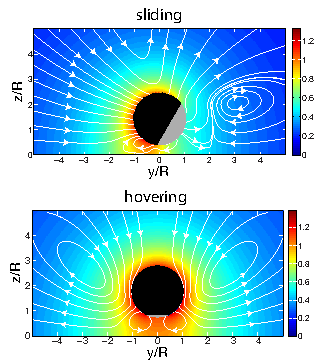 |
| ⚫ | In collaboration with the groups of Prof. I. Kretzschmar at City Univ. of New York (CUNY) and Assist. Prof. W. Uspal at Univ. of Hawai'i, the occurrence of sliding states at horizontal planar walls that are either below (“floor”) or above (“ceiling”) a model gyrotactic, self-phoretic Janus particle has been studied. “State diagrams” characterizing their occurrence have been constructed. It has been shown that in certain cases sliding states may emerge simultaneously at both the ceiling and the floor, in agreement with experimental reports. [ S. Das, Z. Jalilvand, M.N. Popescu, W.E. Uspal, S. Dietrich, and I. Kretzschmar, Floor- or Ceiling-Sliding for Chemically Active, Gyrotactic, Sedimenting Janus Particles, Langmuir 11, 36, 7133 (2020) ] |
 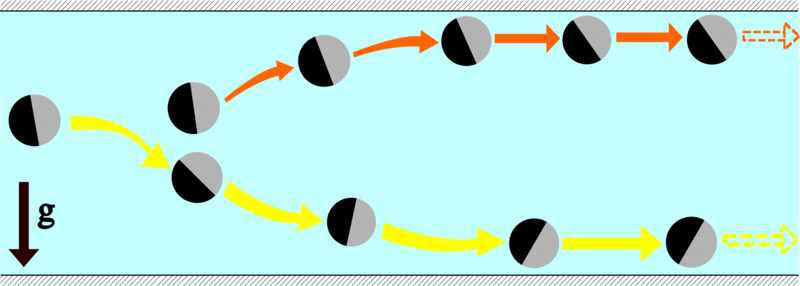 |
| ⚫ | If a chemically (or thermally) active particle is close to a liquid-fluid interface, the inhomogeneous distribution of reactant and product molecules (or temperature) at the interface can induce local variations of the surface tension. This gives rise to interfacial stresses and hence leads to the onset of hydrodynamic flow (the so-called Marangoni flows). We have shown that such flows propagate in the bulk and drive the particle close to (or far away from) the interface. This effective interaction is long ranged and may provide an alternative mechanism to control particle accumulation at fluid-fluid interfaces. [ A. Dominguez, P. Malgaretti, M.N. Popescu, and S. Dietrich, Effective interaction between active colloids and fluid interfaces induced by Marangoni flows, Phys. Rev. Lett. 116, 078301 (2016) ] |
 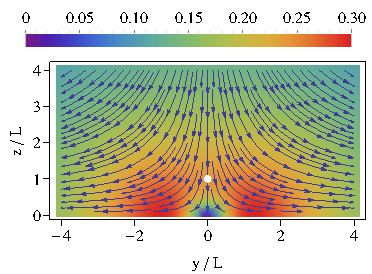 |
| ⚫ | The conditions, under which an active, spherical Janus colloid trapped at a liquid-fluid interface can translate along the interface, have been established. The corresponding persistence length has been estimated and it has been shown that for the particle trapped at the interface the persistence length can be significantly larger than the corresponding one in the bulk liquid, as one can infer from recent experimental results reported by the group of A. Stocco at the Laboratoire Charles Coulomb, University of Montpellier. [ P. Malgaretti, M.N. Popescu, and S. Dietrich, Active colloids at fluid interfaces, Soft Matter 12, 4007 (2016) ] |
 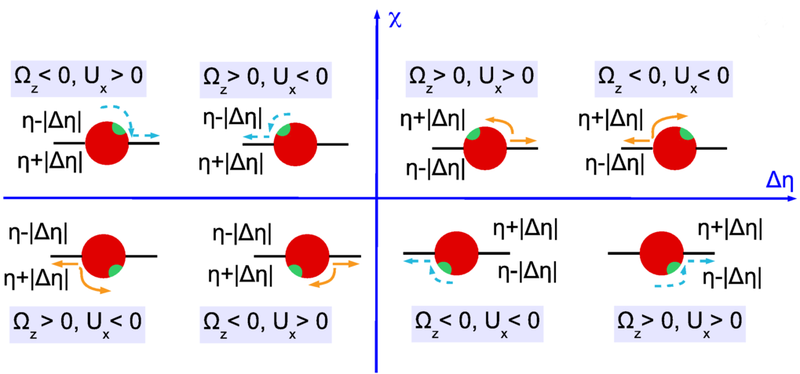 |
| ⚫ | When active swimmers are confined in varying-section channels the hydrodynamic interactions with the channel walls can induce novel dynamical regimes. We derive analytic expressions for the lateral probability distribution of a dilute suspension of swimmers cofined inside channels fo varying cross-section. Our results show that the accumulation of microswimmers at channel walls is sensitive to both the underlying swimming mechanism and the geometry of the channels. Finally, for asymmetric channel corrugations, our model predicts a rectification of microswimmers along the channel, the strength and direction of which strongly depends on the swimmer type. [ P. Malgaretti and H. Stark, Model microswimmers in channels with varying cross section, J. Chem. Phys 146, 174901 (2017) ] |
 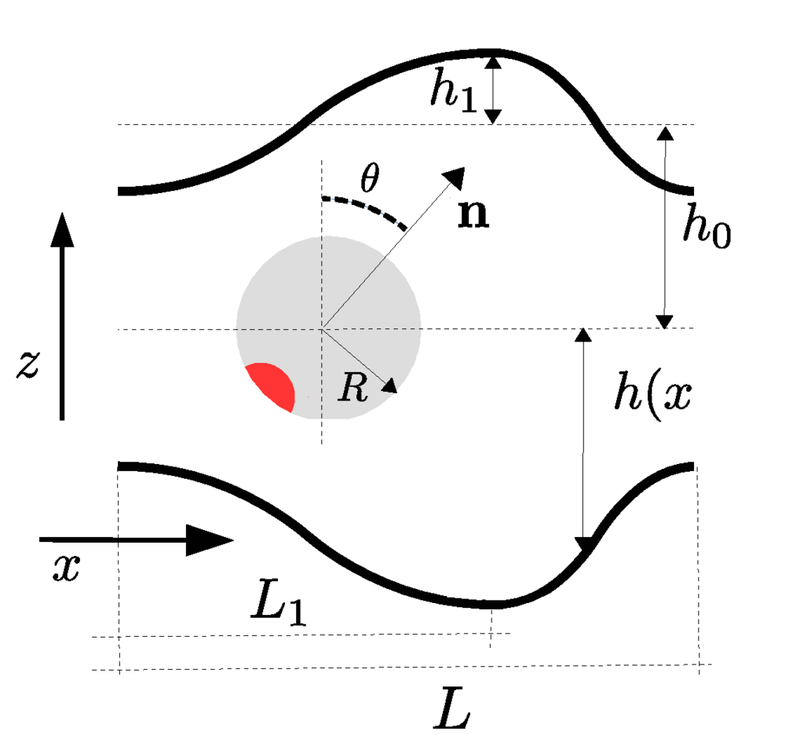 |
Tactic response of active particles
| ⚫ | For walls which are topographically patterned, novel states of "guided" motion along the edges of the patterns emerge when the parameters of the particles are such that a sliding state occurs in the absence of the patterns. Such "topography-guided" states emerge from a complex interplay between chemical activity of the particle, hydrodynamic interactions, and the confinement of the chemical and hydrodynamic fields by the topography. These states have been studied in collaboration with the "Lab-in-a-tube and Nanorobotic Biosensors" group (Prof. S. Sánchez) at the MPI-IS. [ J. Simmchen, J. Katuri, W.E. Uspal, M.N. Popescu, M. Tasinkevych and S. Sánchez, Topographical pathways guide chemical microswimmers, Nat. Comm. 7, 10598 (2016) ] |
 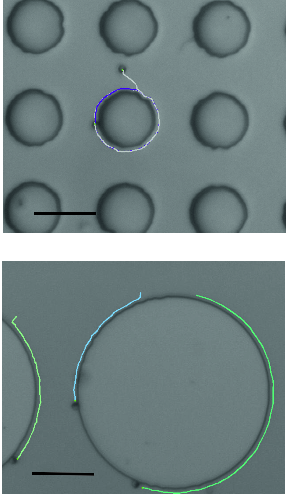 |
| ⚫ | "Rheotaxis" denotes the spontaneous polarization of the orientation of a microswimmer in the presence of ambient flow. For spherical objects the shape-symmetry rules out the "weather vane" mechanism of rheotaxis (which is operational for elongated swimmers). We have shown that for chemically active spherical particles in shear flow near a planar surface a novel mechanism of upstream rheotaxis may emerge from the interplay between wall-confined activity and hydrodynamics. Furthermore, the additional phenomenology of cross-stream rheotaxis has been evidenced and studied both theoretically and experimentally in collaboration with the group "Smart nano-bio-devices" (Prof. S. Sánchez) at the IBEC Barcelona and with Dr. J. Simmchen at TU Dresden. [ W.E. Uspal, M.N. Popescu, S. Dietrich, and M. Tasinkevych, Rheotaxis of spherical active particles near a planar wall, Soft Matter 11, 6613 (2015); J. Katuri, W.E. Uspal, J. Simmchen, A. Miguel-López, S. Sánchez, Cross-stream migration of active particles, Science Adv. 4, eaao1755 (2018) ] |
 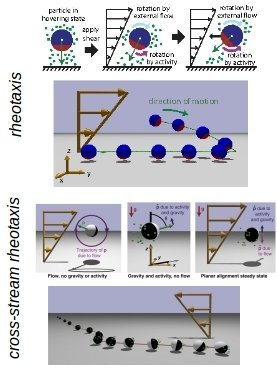 |
| ⚫ | In collaboration with the group Micro, Nano, and Molecular Systems (Prof. P. Fischer) at the MPI-IS and with Dr. L. Wilson at the Univ. of York the self-propelled motion of photo-chemically active titania/silica particles, which are bottom heavy and posses self-shadowing properties, has been studied. When the particle are immersed in peroxide solutions and UV illuminated, at low light intensities they exhibit wall-bound states of motion while upon sufficiently increasing the intensity of light they lift off from the wall and swim against gravity and away from the light source. The phenomenology is captured by a theoretical model within the framework of self-diffusiophoresis which explicitely accounts for the shadwoing effect on the photochemical activity. [ D.P. Singh, W.E. Uspal, M.N. Popescu, L.G. Wilson, and P. Fischer, Photogravitactic Microswimmers, Adv. Func. Mater. 28, 1706660 (2018) ] |
 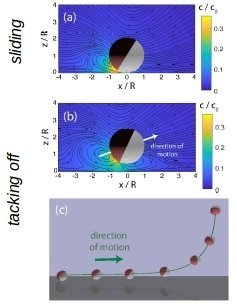 |
| ⚫ | The active motility (translation and rotation) of chemically active Janus particles depends, in general, on the fuel concentration. We have provided a simple, intuitive description of the underlying mechanisms for the active coupling of the orientation of the particle to a gradient in chemical fuel, as well as a classification (in the lowest order response) of the active particles exhibiting positive or negative chemotaxis. This provides guidance for engineering a specific response and is a useful organizing framework for the quantitative analysis and modeling of chemotactic behaviors. [ M.N. Popescu, W.E. Uspal, C. Bechinger, and P. Fischer, Chemotaxis of Active Janus Nanoparticles, Nano Lett. 8, 5348 (2018) ] |
  |
Non-spherical shapes, complex surface-activity patterns
| ⚫ | A new design of active colloids, consisting of a hollow, spherical, porous shell decorated on the inside by a catalyst, was developed by the group "Smart nano-bio-devices" (Prof. S. Sánchez) at the MPI-IS. The motility of these particles with "reversed" Janus structure (the catalyst is inside the cavity) was modeled in terms of a self-phoretic mechanism. In agreement with the experimental observations, the model predicts phoretic motion towards the non-metallic side, where the exterior solution is rich in product molecules. This direction of motion presents an unexpected contrast with the case in which the catalyst is on the outside, for which motion is directed away from high product concentrations. [ X. Ma et al, Reversed Janus Micro/Nano-Motors with Internal Chemical Engine, ACS Nano 10, 8751 (2016) ] |
  |
| ⚫ | The motion of a spherical particle with arbitrary catalytic patches and non-uniform chemical activity is investigated. The model may explain a well-defined circular motion observed in recent experiments. The resulting trajectories are in general helical, and their pitch and radius can be controlled by adjusting the angle between the translational and angular velocity. [ M. Lisicki, S. Y. Reigh, and E. Lauga, Autophoretic motion in three dimensions, Soft Matter 14, 3304 (2018) ] |
 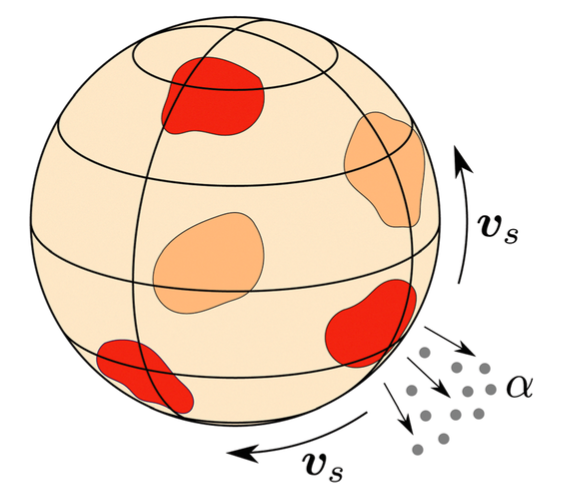 |
| ⚫ | In contrast to the case of a spherical squirmer, for a spheroidal squirmer each slip mode excites either all of the fore-aft symmetric or fore-aft asymmetric components of the flow field, respectively, and contributes to the velocity or to the stresslet. Accordingly, a spheroidal squirmer possesses simple means – not available to a spherical one – for acting in hydrodynamic disguise, which can be advantageous as either predator or prey. [ R Pöhnl, M.N. Popescu, and W. Uspal, Axisymmetric spheroidal squirmers and self-diffusiophoretic particles, J. Phys.: Condens. Matter 32, 164001 (2020) ] |
 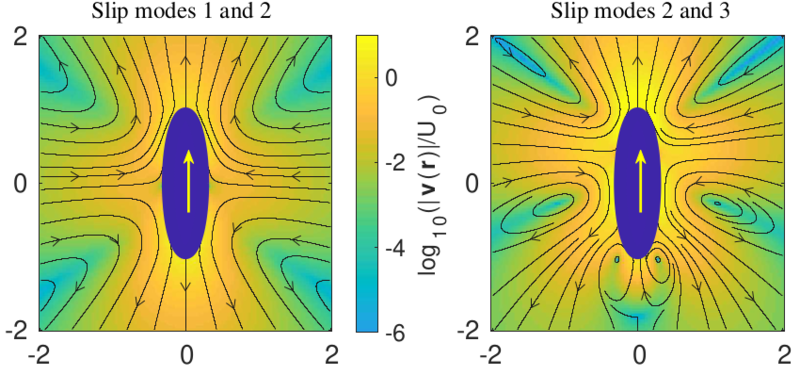 |
Collective dynamics in monolayers of active particles
| We derive a mean-field model for the dynamics of the large-scale spatial distribution of a monolayer of spherically symmetric active particles trapped at a fluid-fluid interface. The model accounts for direct pair interactions as well as hydrodynamic interactions (including the Marangoni flow induced by the response of the interface to the chemical activity). A situation of particular interest occurs if the pair interaction includes capillary interactions. The model predicts that in typical experiments (i.e., the activity of the particles leads to a decrease of surface tension) the activity-induced Marangoni flow can prevent the clustering instability driven by capillary attraction. [ A. Domínguez, P. Malgaretti, M.N. Popescu, and S. Dietrich, Collective dynamics of chemically active particles trapped at a fluid interface, Soft Matter 12, 8398 (2016) ] |
 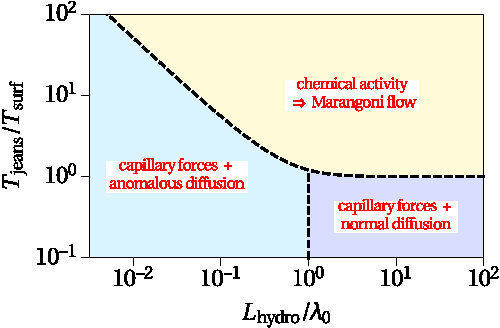 |
| A monolayer of spherically symmetric active particles, located at a fluid-fluid interface and interacting via a "soft" repulsive potential, exhibits collective dynamics driven by the long-ranged Marangoni flows due to the response of the interface to the activity of the particles. Using a mean-field model, we demonstrate that, in spite of the intrinsic out-of-equilibrium character of the system, the monolayer evolves to a "pseudoequilibrium" state in which the Marangoni flows force the coexistence of the thermodynamic phases associated to the direct interaction in a radially stratified, "onion-like" structure within the monolayer. [ A. Dominguez and M.N. Popescu, Phase coexistence in a monolayer of active particles induced by Marangoni flows, Soft Matter 14, 8017 (2018) ] |
 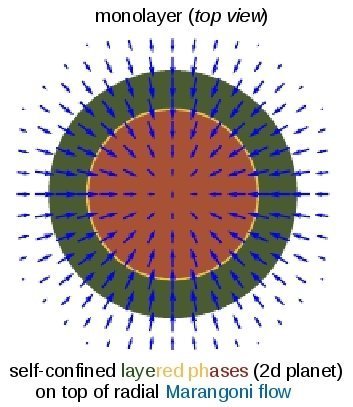 |
Active drops
| ⚫ | In collaboration with the group "Micro, Nano. and Molecular Systems Lab" of Prof. P. Fischer at the MPI-IS and with Prof. A. Dominguez (Univ. of Seville), the behavior of a sessile drop containing active particles with negligible self-propulsion was investigated. For particle-density above a certain threshold, a symmetry breaking transition to collective motion of particles and self-organized flow patterns within the drop is observed. This emerges through a novel mechanism that involves an interplay between the chemical-activity-induced Marangoni stresses at the liquid–liquid interface and the geometrical confinement (by the drop). In ensembles of such active drops long-ranged ordering of the flow patterns within the drops is observed. [D.P.Singh, A. Dominguez, U. Choudhury, S.N. Kottapalli, M.N. Popescu, S. Dietrich, and P. Fischer, Interface-mediated spontaneous symmetry breaking and mutual communication between drops containing chemically active particles, Nature Commun. 11, 2210 (2020)] |
 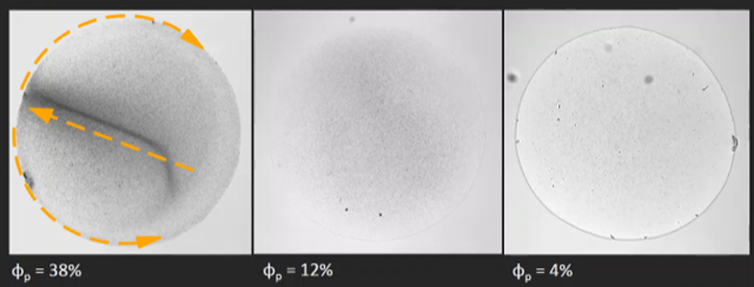 |


